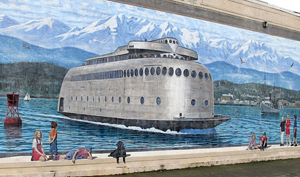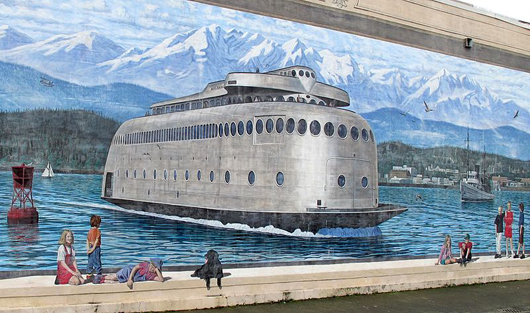
The old 1935 ferryboat, famous for its streamlined, Art-Deco design and tied up in Tacoma’s Hylebos Waterway for the past 6 1/2 years, is taking on water, causing it to list precariously and raising concerns that it’s about to sink.
“It’s a disaster waiting to happen,” said Jeff Barney, Bay Patrol director at the environmental watchdog group, Citizens for a Healthy Bay.
Barney, who patrols Commencement Bay and the tideflats, tracking down pollution, said that at low tides this week, the 276-foot ferry has been listing more than 25 degrees – enough to put openings in its hull below the water line.
“Every time she grounds out, she breaks off pilings and lists farther to the port side and then takes on sea water,” he said.
Water pours in the holes, Barney said, until the rising tide floats the boat again and rights it – at a constantly lower level.
“I’m throwing up the red flags,” Barney said. “It’s taking on an immense amount of water. It’s time to do something, before this becomes a multi-multi-million-dollar cleanup problem.”
Rodrigues, who bought the ferry in 2003 for $135,560, and has championed several creative ideas for restoring and marketing it – including restaurants, a carousel and an ice-skating arena – says the boat is not going to sink. “We’re going to have it righted again in a matter of hours,” he said Friday.
Rodrigues and another man were at the dilapidated Taylor Avenue dock, sliding a large pump onto the steeply sloped deck of the Kalakala along a cable tied off to an abandoned feed storage silo on shore.
Electric power to the boat was provided by a string of extension cords running along the remains of the dock. “We have a lot of plans,” Rodrigues said. “We have a lot going on, but I can’t talk about it right now.”
“What I can say, is we are going from nonprofit to profit. It’s official as of today.”
According to the corporation registry at the secretary of state’s office, Rodrigues’ nonprofit foundation, “The Kalakala Alliance Foundation,” which he’s been using to try to raise money to save the boat, became inactive Jan. 31.
Rodrigues has estimated costs for renovation at $14 million.
The U.S. Coast Guard was at the dock on Friday, too, trying to assess the risk.
“We’re here to see if there is a structural integrity issue with the hull,” Chief Warrant Officer Tim Macon said. “The question is: Is it going to sink?”
Barney and other environmentalists say that if the Kalakala sinks, it will release decades worth of fuel and hazardous chemicals into the Hylebos Waterway.
“The problem is the Hylebos is a Superfund site,” said Bill Anderson, the executive director of Citizens for a Healthy Bay “We can’t afford re-pollution.”
If the Kalakala sinks, Anderson said, several scenarios could ensue: all of them bad – and expensive.
The sunken hulk, and subsequent efforts to raise it, not only would release pollutants, he said, but they would block the busy Hylebos, which accommodates a constant flow of oceangoing ships and barges serving log exporters, an oil refinery and the multinational metals recycler, Schnitzer Steel.
If the Kalakala breaks free from its mooring, it could smash into docks, marinas or industrial facilities along the Hylebos, Anderson said.
Of most concern, he said is the oil refinery directly across the waterway.
“A free-floating vessel across from a fueling station could be catastrophic,” Anderson said.
The Kalakala is connected to shore at its stern with a single, frayed, 2-inch rope. Several of the pilings holding its bow are split or broken. Last month, Barney said, a cluster of pilings to which the Kalakala had been attached broke off and floated down the waterway.
“Things suddenly have gotten decidedly worse,” Anderson said. “Before, the Kalakala was just a creepy-looking ship. Now it’s a serious hazard.”
Marki Allen, an employee of Tri Pak Inc., which leases upland property immediately adjacent to the Kalakala, says she’s run out of patience with Rodrigues and his dreams, which she sees as farfetched and unrealistic.
“I believe in preserving our past and antiques and stuff,” she said, “but this thing is just a menace right now. It’s rusting right into Puget Sound. It’s crap.”
___
Information from: The News Tribune,
http://www.thenewstribune.com
Copyright 2011 Associated Press. All rights reserved. This material may not be published, broadcast, rewritten, or redistributed.
AP-WS-03-26-11 1454EDT
ADDITIONAL IMAGE OF NOTE



